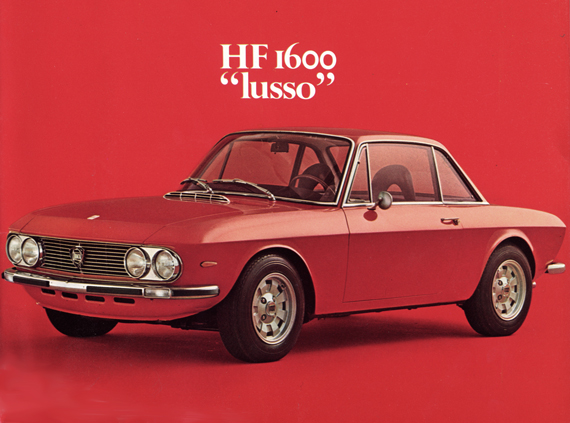
Factory brochure for the Fulvia HF Lusso.The standard S2 1600HF, with standard stainless windshield trim, standard nose badge, and standard S2 Coupé bumpers. The bumpers have both front and side brackets, with side bracket holes below the marker lights.
[Lancia Fulvia 1.6HF chassis number 2269 was covered in detail by Andrew Coles last week. Today, Edward Levin gives us further information about how the HF series developed. Ed.]
By Edward Levin, American Lancia Club
Perhaps because he had raced for Fiat at the beginning of his automotive career, Vincenzo Lancia had always forsworn racing. Others raced his cars, and racing drivers from Nuvolari to (later) Hawthorn chose Lancias as their road cars. But Lancia feared that the enormous expense of a factory competition team would detract from his main aim—selling well-engineered, solidly-built cars to a monied audience.
Vincenzo’s fears were proven prescient when, after the founder’s death, his son Gianni embarked on an ambitious program of sports prototype and formula one racing. While this program had yielded some success and led to the development of some advanced competition cars, it also helped propel the firm into the financial difficulties that led to the family’s sale to a private investor in 1955.
The “High Fidelity” Lancias
For the decade following the sale, only privateers raced Lancias. One such privateer group, the HF Squadra Corse had been organized by Cesare Florio, son of Lancia’s marketing director. The Squadra borrowed the “HF” designation from the HiFi Club, a group of lancisti who bought only Lancias, thus exhibiting their “high fidelity” to the marque. When the factory decided to re-enter competition in the mid-‘60s, it must have seemed natural for the factory to essentially absorb and build upon the HF Squadra Corse.
Therefore beginning around 1965, the factory reconstituted a works racing team, the Reparto Corse, and began to prepare its new front-wheel drive Fulvia model for road racing and rally. And although the newly-introduced Coupé (1.2) saw some initial success, its power-to-weight ratio limited its competitiveness. To address this, in 1966 the factory created a lightweight homologation version of the Coupé, officially known as the “Coupé HF”, but now referred to as the 1.2HF.